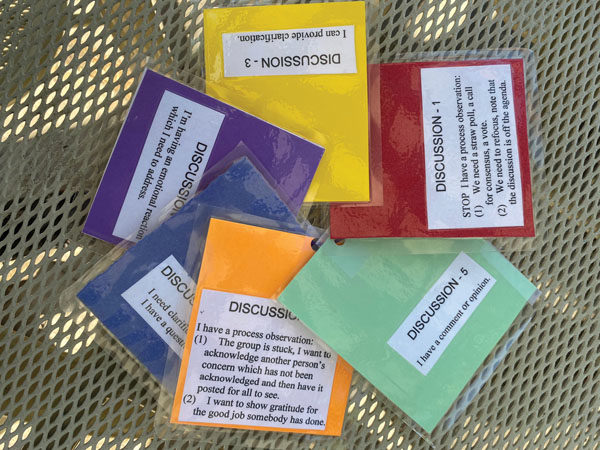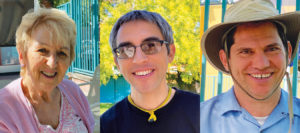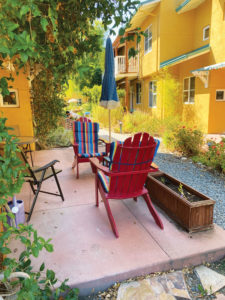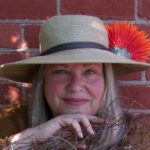Pleasant Hill Cohousing founder sees communal living as sustainable way of the future

PLEASANT HILL, CA (Oct. 14, 2021) — The scale is human and the vibe bucolic at the tiny “village” with mango-colored townhouses that make up the hidden oasis called Pleasant Hill Cohousing (PHCH).
With cars banished to the periphery, the homes sit on welcoming, winding paths lined with lush greenery that manages to be orderly and wild at the same time.
PHCH is home to 32 households and 60+ people who have made a commitment to “live in a community that fosters harmony with each other, the larger community and nature.”
Tucked away on a 2.2-acre triangle of land just off Monument Boulevard, wedged between the Contra Costa Canal and the Iron Horse Trail, PHCH is part of a growing movement of intentional communities. The neighborhoods combine the privacy of individual homes –generally townhouses or condominiums – with shared amenities like laundry facilities, gardens, craft rooms, exercise equipment, workshops, libraries, gathering spaces and sometimes even cars.
Governing by consensus
Cohousing groups are small, participatory democracies based on shared ideals of communication and cooperation. Governance is by consensus, not an easy process in any size group, no matter how committed.
“Our self-governance has evolved and improved over time,” observed PHCH resident Kenji Yamada, who noted that cohousing is not for everyone, perhaps not even for most people.
To reach consensus on issues during monthly meetings, the group adopted an innovative system that utilizes a series of colored cards that signal their positions. Various colors indicate “More Info Needed,” “Point of Order,” “Not Decided Yet,” etc. Green=Agree, Red=Block. The goal is to see a sea of green, of course.
Seeking stronger connections

Yamada, a former Peace Corps volunteer, now a software tester and community activist, is typical of PHCH residents, if not most “communitarians,” as they are sometimes called, in his motivation for choosing cohousing. He and his wife sought to live in a place that offered more real connections to neighbors than typical suburban living.
They were seeking an old-fashioned sense of neighborhood that affords opportunities to connect with each other and interact in meaningful ways, an antidote to the isolation of much modern life.
New resident Timothy Silk, a tech consultant, echoes Yamada’s desire for closer contact with his neighbors. When he and his wife, empty nesters, were exploring local cohousing options, he was impressed by how much the PHCH residents seemed to care for each other. New members, for example, are treated to a welcoming ceremony.
Pre-COVID, there were many celebrations and gatherings in addition to the twice-a-week communal meals in the Common House, which contains, in addition to a kitchen, a dining room (Great Room), sitting room, laundry, kids’ room, teen room, crafts room and two guest bedrooms with bath – a welcome feature.
Bringing the concept to America
The same desire for more real connections to her neighbors prompted PHCH co-founder (and project guiding force) Barbara Lynch and her late husband to gather like-minded folks in 1995 to seek a parcel of land suitable for building what would become the first cohousing development in Contra Costa County.
“We were living the dream, a big house with a pool in Walnut Creek,” says the former Los Medanos College computer sciences teacher. “But when I read an article about a cohousing project on Bainbridge Island in Washington, I knew immediately that I wanted to live in a more conscious, cooperative way – I wanted to live in cohousing.”
In 2001, she got her wish, moving into the newly completed PHCH complex.

By happy coincidence, the Bay Area was home to architects Charles Durrett and his then-wife Kathryn McCamant, who introduced the idea of cohousing (and coined the term) to the United States in the late ’80s.
They had previously lived in Denmark, where the concept was pioneered in the 1970s before spreading throughout Europe and, thanks to Charles and Kathryn, to this country.
The architects and their Cohousing Company, based in Berkeley for many years and now in Nevada City, remain devoted to the cohousing concept. They wrote books and articles, held introductory meetings and helped many groups navigate the often-difficult process of creating their own communities.
Working closely with Lynch and the Pleasant Hill group, they designed a community that is multigenerational, diverse, non-hierarchical and environmentally conscious with passive heating and cooling features, efficient water use, natural, non-toxic materials and many more amenities.
“Cohousing helps stem the tide of consumerism,” Durrett told the Pioneer. “Instead of 32 lawnmowers, you only need one, for example.”
Daring to soldier on
Durrett sees his job as helping to create a viable society and sees the biggest obstacle to cohousing development as a culture stuck in outdated ideas about living arrangements.
After designing the first newly constructed cohousing community in the country, Muir Commons in Davis, in 1991, and PHCH in 2001, Durrett remains undeterred. He has completed more than 50 of the more than 150 cohousing communities in the country.
Cooperation is the key to human survival. It is the basis of how we live together in families, in communities, of how we govern ourselves and of the global economy.
Cohousing offers a compelling model for getting along and – in these difficult times – for addressing our increasing isolation.
Kurt Vonnegut once wrote, “The most daring thing is to create stable communities in which the terrible disease of loneliness can be cured.”
The Pleasant Hill Cohousing folks have taken the dare.

Pamela Michael
Pamela Michael is a writer and communications specialist who has lived in Curry Canyon for twenty years.
